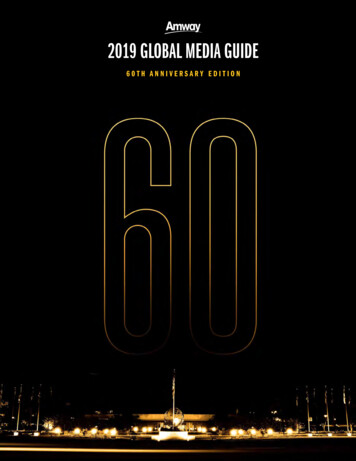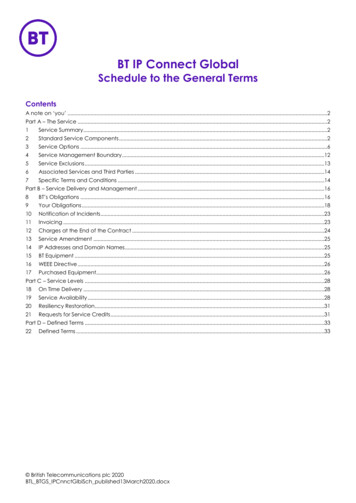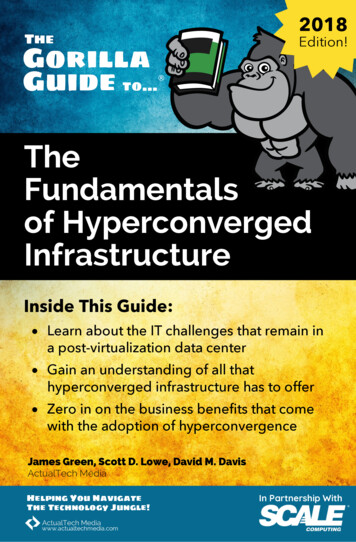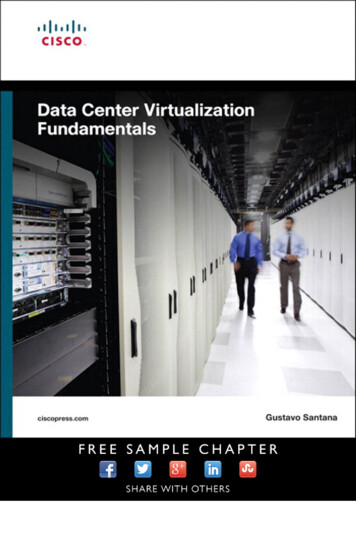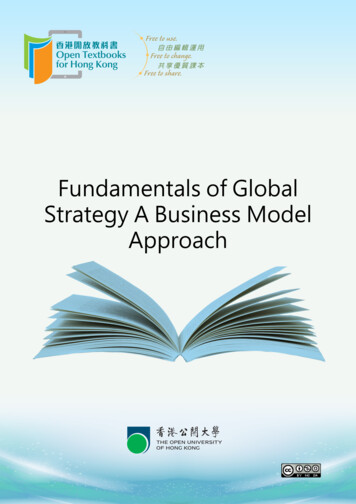
Transcription
Fundamentals of GlobalStrategy A Business ModelApproach
Printing HistorySeptember 2012: Fundamentals of Global StrategyThis work is licensed under a Creative Commons-NonCommercial-ShareAlike 4.0International LicenseOriginal source: Saylor Academyhttp://www.saylor.org/books/
ContentsPreface .1Organization of the Book.2Minicases and Appendices .2Chapter 1 Competing in a Global World .41.1 How Global Are We?.4Minicase: The Globalization of Wal-Mart .71.2 Global Competition’s Changing Center of Gravity.81.3 Globalization Pressures on Companies .91.3.1 Growth .91.3.2 Efficiency .101.3.3 Knowledge .101.3.4 Customer Needs and Preferences .111.3.5 Competition .11Minicase: Chocolatiers Look to Asia for Growth .121.4 What Is a Global Corporation? .131.5 The Persistence of Distance .141.5.1 Cultural Distance .141.5.2 Administrative or Political Distance .151.5.3 Geographic Distance .151.5.4 Economic Distance .16Minicase: Computer Keyboards Abroad: QWERTZ Versus QWERTY .171.6 Global Strategy and Risk .171.7 Points to Remember .20Chapter 2 The Globalization of Companies and Industries .212.1 The Five Stages of Going Global .212.2 Understanding Industry Globalization.22Minicase: Cemex’s Globalization Path: First Cement, Then Services .242.3 Clustering: Porter’s National Diamond .252.3.1 Factor Conditions .262.3.2 Home-Country Demand .272.3.3 Related and Supporting Industries .272.3.4 Competitiveness of t he Home Industry .272.3.5 Public Policy and Chance .282.4 Industry Globalization Drivers .282.4.1 Market Drivers .282.4.2 Cost Globalization Drivers .292.4.3 Competitive Drivers .292.4.4 Government Drivers .30Minicase: Global Value Chains in the Automotive Industry: A NestedStructure .312.5 Globalization and Industry Structure .322.6 Points to Remember .36
Chapter 3 Generic Strategies for Global Value Creation.373.1 Ghemawat’s “AAA” Global Strategy Framework .373.1.1 Adaptation.37Minicase: McDonald’s McAloo Tikki .393.1.2 Aggregation .41Minicase: Globalization at Whirlpool Corporation .423.1.3 Arbitrage.44Minicase: Indian Companies Investing in Latin America? To Serve U.S.Customers? .463.2 Which “A” Strategy Should a Company Use? .473.3 From A to AA to AAA.483.3.1 PursuingAdaptation and Aggregation .483.3.2 Aggregation and Arbitrage .493.3.3 Arbitrage and Adaptation.493.3.4 Developing an AAA Strategy .503.4 Pitfalls and Lessons in Applying the AAA Framework .513.5 Points to Remember .52Chapter 4 Global Strategy as Business Model Change .544.1 Components of a Business Model .544.2 Global Strategy as Business Model Change .56Minicase: Microsoft in China .574.3 Value Disciplines and Business Models .60Minicase: Air Arabia Leads the World in Operational Excellence .62Minicase: Customer Intimacy at the Four Seasons .64Minicase: How Apple Maintains Product Leadership .674.4 Choosing a Value Discipline or Selecting a Target Market? .704.5 Market Leadership and Value Disciplines .71Minicase: Dell in Asia: Adapt or Change? .724.6 Points to Remember .73Chapter 5 Target Markets and Modes of Entry .745.1 Target Market Selection.745.2 Measuring Market Attractiveness .765.2.1 Market Size and Growth Rate .775.2.2 Institutional Contexts.785.2.3 Competitive Environment .79Minicase: Which BRIC Countries? A Key Challenge for Carmakers .795.2.4 Cultural, Administrative, Geographic, and Economic Distance .82Minicase: Tata Making Inroads Into China .835.3 Entry Strategies: Modes of Entry .84Minicase: Coca-Cola and Illycaffé .865.4 Entry Strategies: Timing .86Minicase: Starbucks’ Global Expansion .885.5 Points to Remember .90Chapter 6 Globalizing the Value Proposition .926.1 Value Proposition Adaptation Decisions .92
Minicase: Kraft Reformulates Oreo Cookies in China .956.2 Adaptation or Aggregation: The Value Proposition Globalization Matrix .97Minicase: Starwood’s Branding in China .99Minicase:KFCAbroad . 101Minicase: Targeting Muslim Customers . 1026.3 Combining Aggregation and Adaptation: Global Product Platforms . 103Minicase: Creating the Perfect Fit: New Car-Seat Design . 1046.4 Combining Adaptation and Arbitrage: Global Product Development . 1056.5 Combining Aggregation, Adaptation, and Arbitrage: Global Innovation . 106Minicase: P&G’s Success in Trickle-Up Innovation: Vicks Cough Syrup With Honey. 1086.6 PointstoRemember . 110Chapter 7 Global Branding .1117.1 Global Branding Versus Global Positioning. 111Minicase: Global Positioning of MasterCard . 1127.2 Global Brand Structures . 113Minicase: Henkel’s “Fox” Brands: An Example of a Hybrid Strategy . 1147.3 Determinants of Global Brand Structure . 1157.3.1 Firm-Based Characteristics . 116Minicase: Pharmaceutical Companies Try Global Branding . 1177.3.2 Product-Market Factors . 118Minicase: Use of Country of Origin Effects in Global Branding . 1207.3.3 Market Dynamics. 1217.4 Formulating a Global Brand Strategy . 1227.5 Managing Key Strategic Brands . 1237.5.1 Benefits of Corporate Branding . 1247.5.2 Corporate Brand as the “Face of the Company” . 1247.5.3 Simplicity . 1257.5.4 Cost Savings . 1257.5.5 Corporate Brands as Assets. 125Minicase: The Best Global Brands . 1257.5.6 Financial Analysis . 1267.5.7 Role of Brand Analysis . 1277.5.8 Brand Strength Score . 1277.5.9 Brand Value .
Fundamentals of Global Strategy A Business Model Approach. This document was created with Prince, a great way of getting web content onto paper.




![Global Commercial Strategy [L6M2] - CIPS](/img/2/l6m2-sample-answer-20guide-fv-20v3.jpg)



